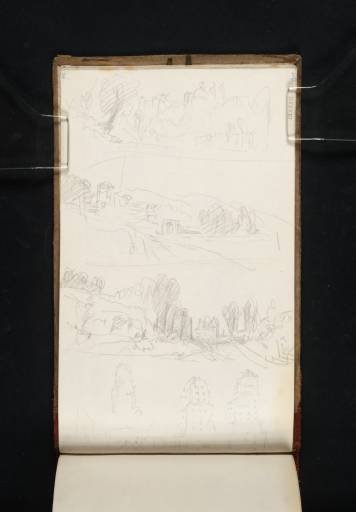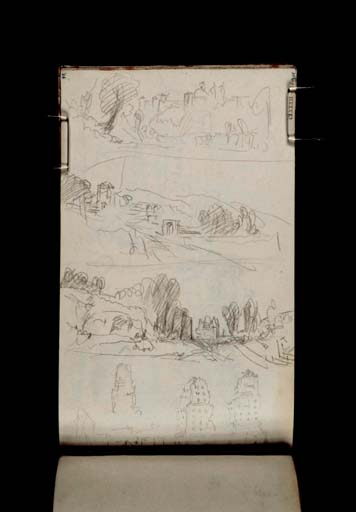Joseph Mallord William Turner Four Landscape Sketches of the Road between Albano and Ariccia 1819
Image 1 of 2
Joseph Mallord William Turner,
Four Landscape Sketches of the Road between Albano and Ariccia
1819
Joseph Mallord William Turner 1775–1851
Folio 83 Recto:
Four Landscape Sketches of the Road between Albano and Ariccia 1819
D15454
Turner Bequest CLXXXII 82
Turner Bequest CLXXXII 82
Pencil on white wove paper, 189 x 113 mm
Inscribed by the artist in pencil ‘Road’ centre left underneath second sketch from bottom
Inscribed by John Ruskin in blue ink ‘82’ top left, ascending left-hand edge and ‘301’ top right, ascending right-hand edge
Stamped in black ‘CLXXXII 82’ top right, ascending right-hand edge
Inscribed by John Ruskin in blue ink ‘82’ top left, ascending left-hand edge and ‘301’ top right, ascending right-hand edge
Stamped in black ‘CLXXXII 82’ top right, ascending right-hand edge
Accepted by the nation as part of the Turner Bequest 1856
References
1909
A.J. Finberg, A Complete Inventory of the Drawings of the Turner Bequest, London 1909, vol.I, p.539, as ‘Road, approaching L’Ariccia’.
1984
Cecilia Powell, ‘Turner on Classic Ground: His Visits to Central and Southern Italy and Related Paintings and Drawings’, unpublished Ph.D thesis, Courtauld Institute of Art, University of London 1984, p.194 note 102.
1987
Cecilia Powell, Turner in the South: Rome, Naples, Florence, New Haven and London 1987, p.[88] note 78.
The four sketches on this page depict different points along the road between Albano and Ariccia, with the geographical progression from the bottom to the top of the page.
The main focus of the sketch at the bottom is the so-called Tomb of Pompey, or Ascanius, a three-storey structure punctuated by square blocks which lies on the Via Appia near the entrance to Albano. Andrew Lumisden described it in 1812 as ‘the remains of a magnificent mausoleum ... incrusted with marble, and each story ornamented with columns, no doubt of different orders. Though robbed of these columns and the incrustation, yet the bells, or praecinationes of these stories, and the marble blocks to which they were fixed still remain, and point out its former state’.1 The tomb was recorded by Piranesi in his Antichità d’Albano e di Castel Gandolfo 1764,2 and in a 1796 drawing by Carlo Labruzzi, the artist who accompanied Richard Colt Hoare on his journey through Italy in 1789.3 Here Turner has drawn it twice, from different sides. See also folio 2 (D15298).
The scene second from bottom depicts the approach to the so-called Tomb of the Horatii and Curiatii, near the Church of Santa Maria della Stella on the edge of Albano towards Ariccia. Once comprised of five conical towers on a square peperino base, the tomb was popularly attributed to the mythical brothers of the Horatii and Curiatti who fought each other to avoid war between Rome and Alba Longa, although other scholars have ascribed it to Pompey the Great, to Aruns, son of Porsena, or to the Arruntii family of Albano.4 The upper left corner of the sketch beneath also contains a study of one of the two surviving cones. Further sketches can be found in the Naples, Paestum, Rome sketchbook (see Tate D16030; Turner Bequest CLXXXVI 61a). The unusual architectural design of the tomb and the appearance of crumbling ruins overrun with weeds and shrubs made it an attractive motif for artists and Turner may have been familiar with images of it by James Hakewill (1778–1843) and Giovanni Battista Piranesi (1720–1778).5 It was also the subject of a couple of copies, probably after John Robert Cozens (1752–1797), made by Turner and Thomas Girtin (1775–1802) for Dr Monro’s Album of Italian Views, 1794–6 (see Tate D36420 and D36440; Turner Bequest CCCLXXIII 7 and 27).
The rough nature of the second sketch from the top makes it difficult to identify with certainty but comparison to a drawing by Hakewill, On the Road from Albano to Ariccia 1817 (British School at Rome Library) indicates that it may depict the road behind the Church of Santa Maria della Stella, beyond the Tomb of the Curiatii.6 Corresponding details in Hakewill’s composition suggests that the arched structure in the centre is a roadside altar whilst the church on the higher ground on the left.
The sketch at the top records a view well-known to landscape artists in the eighteenth and nineteenth centuries, the town of Ariccia seen from the road beneath the escarpment to the north-west. Although swiftly executed, Turner’s drawing exactly repeats the composition of images by other artists, with the Palazzo Chigi on the left and Bernini’s Church of Santa Maria dell’Assunzione on the right (see for example Richard Wilson, Ariccia circa 1754–6, Tate, T08164). Turner made a more thorough study of the view on the next page, see folio 83 verso (D15455; Turner Bequest CLXXXII 82a).
Nicola Moorby
May 2008
Tony Cubberley and Luke Herrmann, Twilight of the Grand Tour: A Catalogue of the drawings by James Hakewill in the British School at Rome Library, Rome 1992, p.240.
James Hakewill, Tomb of Curiatii at Albano 1817 (British School at Rome Library), see Cubberley and Herrmann 1992, no.5.15, p.240 reproduced; Giovanni Battista Piranesi, Tomb of the three Curiatii brothers in Albano (Sepolcro delle tre fratelli Curiatii in Albano) 1765, etching from Le Antichità Romane.
How to cite
Nicola Moorby, ‘Four Landscape Sketches of the Road between Albano and Ariccia 1819 by Joseph Mallord William Turner’, catalogue entry, May 2008, in David Blayney Brown (ed.), J.M.W. Turner: Sketchbooks, Drawings and Watercolours, Tate Research Publication, December 2012, https://www


